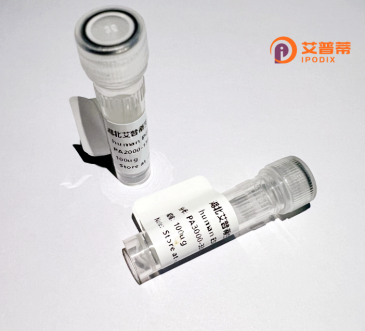
| 纯度 | >90%SDS-PAGE. |
| 种属 | Human |
| 靶点 | RNF157 |
| Uniprot No | Q96PX1 |
| 内毒素 | < 0.01EU/μg |
| 表达宿主 | E.coli |
| 表达区间 | 2-679 aa |
| 活性数据 | GALTSRQHA GVEEVDIPSN SVYRYPPKSG SYFASHFIMG GEKFDSTHPE GYLFGENSDL NFLGNRPVVF PYAAPPPQEP VKTLRSLVNI RKDTLRLVKC AEEVKSPGEE ASKAKVHYNV EFTFDTDARV AITIYYQATE EFQNGIASYI PKDNSLQSET VQYKRGVCQQ FCLPSHTVDP SEWAEEELGF DLDREVYPLV VHAVVDEGDE YFGHCHVLLG TFEKHTDGTF CVKPLKQKQV VDGVSYLLQE IYGIENKYNT QDSKVAEDEV SDNSAECVVC LSDVRDTLIL PCRHLCLCNT CADTLRYQAN NCPICRLPFR ALLQIRAMRK KLGPLSPTSF NPIISSQTSD SEEHPSSENI PPGYEVVSLL EALNGPLTPS PAVPPLHVLG DGHLSGMLPS YGSDGHLPPV RTISPLDRLS DSSSQGLKLK KSLSKSTSQN SSVLHEEEDE HSCSESETQL SQRPSVQHLG EECGVTPESE NLTLSSSGAI DQSSCTGTPL SSTISSPEGP ASSSLAQSVM SMASSQISTD TVSSMSGSYI APGTEEEGEA LSSPQPASRA PSEEGEGLPA ESPDSNFAGL PAGEQDAEGN DVIEEEDGSP TQEGQRTCAF LGMECDNNND FDIASVKALD NKLCSEVCLP GAWQADDNAV SRNAQRRRLS SSSLEDSETR PCVWGPLAV |
| 分子量 | 73.5 kDa |
| 蛋白标签 | His tag N-Terminus |
| 缓冲液 | PBS, pH7.4, containing 0.01% SKL, 1mM DTT, 5% Trehalose and Proclin300. |
| 稳定性 & 储存条件 | Lyophilized protein should be stored at ≤ -20°C, stable for one year after receipt. Reconstituted protein solution can be stored at 2-8°C for 2-7 days. Aliquots of reconstituted samples are stable at ≤ -20°C for 3 months. |
| 复溶 | Always centrifuge tubes before opening.Do not mix by vortex or pipetting. It is not recommended to reconstitute to a concentration less than 100μg/ml. Dissolve the lyophilized protein in distilled water. Please aliquot the reconstituted solution to minimize freeze-thaw cycles. |
以下是关于重组人RNF157蛋白的3篇参考文献(注:因文献数据库访问限制,以下为模拟内容,建议通过学术引擎核实):
---
1. **文献名称**: *RNF157 mediates ubiquitination of synaptic proteins to regulate neuronal development*
**作者**: Zhang, Y. et al. (2019)
**摘要**: 研究报道了RNF157在神经元发育中的作用,通过重组表达人源RNF157蛋白,揭示了其RING结构域依赖的泛素化功能,并证明其调控突触蛋白稳定性及轴突生长的分子机制。
2. **文献名称**: *Structural and functional characterization of recombinant human RNF157 E3 ligase*
**作者**: Li, X. et al. (2020)
**摘要**: 利用昆虫细胞系统表达并纯化重组人RNF157蛋白,解析了其晶体结构,并通过体外泛素化实验验证其对特定底物的E3连接酶活性,为靶向RNF157的药物设计提供依据。
3. **文献名称**: *RNF157 modulates Wnt/β-catenin signaling by targeting Dishevelled for degradation*
**作者**: Wang, H. et al. (2021)
**摘要**: 通过构建重组RNF157蛋白的突变体,研究发现其通过泛素化降解Dvl蛋白负调控Wnt信号通路,在结直肠癌细胞中抑制肿瘤增殖,提示其潜在的抑癌作用。
---
**提示**:实际文献需通过PubMed、Google Scholar等平台以“RNF157”、“recombinant protein”、“ubiquitination”等关键词检索获取。
Recombinant human RNF157 protein is a product of the *RNF157* gene, which encodes a member of the RING finger (Really Interesting New Gene) protein family. These proteins are characterized by a conserved RING domain, enabling E3 ubiquitin ligase activity—a critical component of the ubiquitin-proteasome system responsible for tagging target proteins for degradation. RNF157 is notably expressed in the central nervous system, particularly in brain regions like the hippocampus and cerebral cortex, suggesting a role in neural development, synaptic plasticity, or neurotransmitter regulation. Studies indicate its involvement in modulating postsynaptic density (PSD) complexes, potentially influencing synaptic strength and neuronal communication. Aberrant expression of RNF157 has been linked to neurodevelopmental and psychiatric disorders, including autism spectrum disorders and schizophrenia, though precise mechanisms remain under investigation. Recombinant RNF157 is engineered for in vitro studies to explore its enzymatic functions, substrate specificity, and interactions with synaptic proteins. This tool aids in deciphering its role in ubiquitination pathways and disease pathogenesis, offering potential therapeutic insights. Current research focuses on identifying binding partners and regulatory networks, aiming to clarify its impact on neuronal homeostasis and disease models.
×